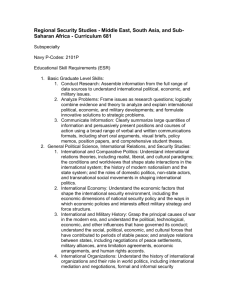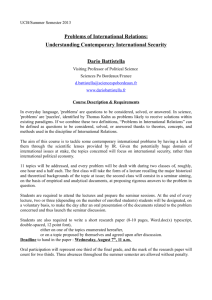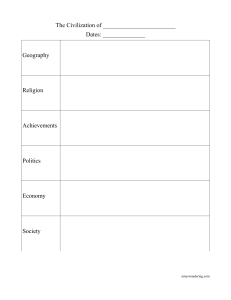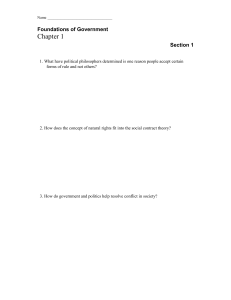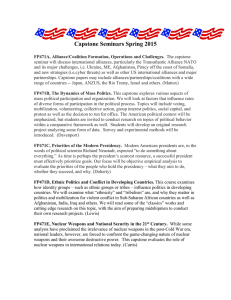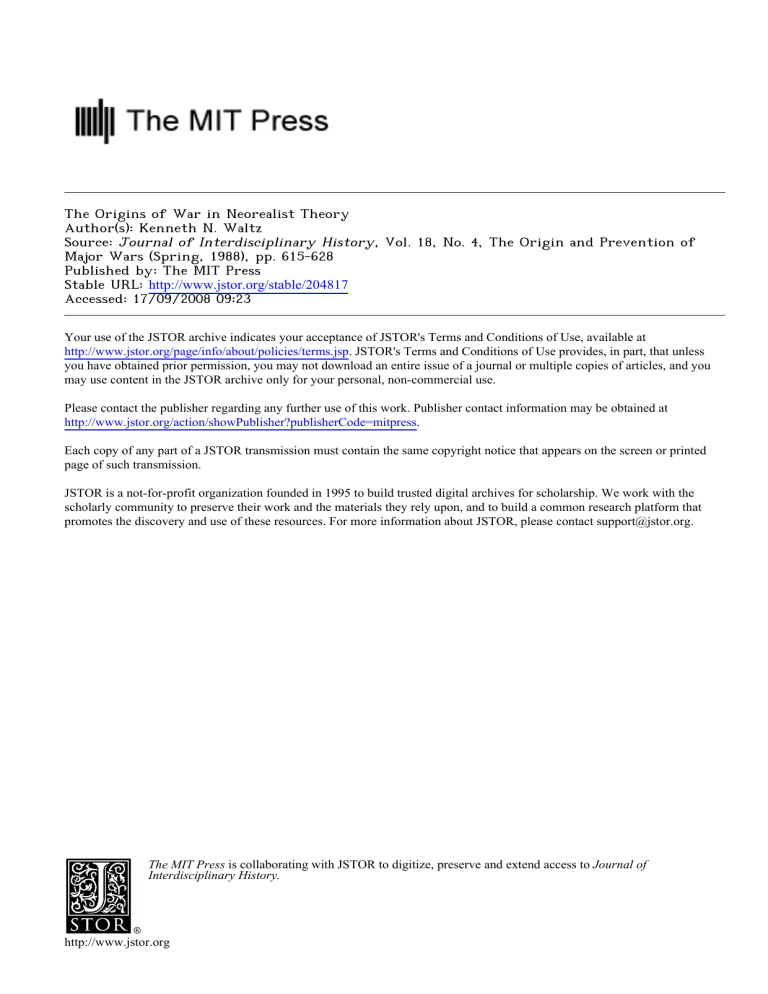
The Origins of War in Neorealist Theory Author(s): Kenneth N. Waltz Source: Journal of Interdisciplinary History, Vol. 18, No. 4, The Origin and Prevention of Major Wars (Spring, 1988), pp. 615-628 Published by: The MIT Press Stable URL: http://www.jstor.org/stable/204817 Accessed: 17/09/2008 09:23 Your use of the JSTOR archive indicates your acceptance of JSTOR's Terms and Conditions of Use, available at http://www.jstor.org/page/info/about/policies/terms.jsp. JSTOR's Terms and Conditions of Use provides, in part, that unless you have obtained prior permission, you may not download an entire issue of a journal or multiple copies of articles, and you may use content in the JSTOR archive only for your personal, non-commercial use. Please contact the publisher regarding any further use of this work. Publisher contact information may be obtained at http://www.jstor.org/action/showPublisher?publisherCode=mitpress. Each copy of any part of a JSTOR transmission must contain the same copyright notice that appears on the screen or printed page of such transmission. JSTOR is a not-for-profit organization founded in 1995 to build trusted digital archives for scholarship. We work with the scholarly community to preserve their work and the materials they rely upon, and to build a common research platform that promotes the discovery and use of these resources. For more information about JSTOR, please contact support@jstor.org. The MIT Press is collaborating with JSTOR to digitize, preserve and extend access to Journal of Interdisciplinary History. http://www.jstor.org Journal of Interdisciplinary History, xvIII:4 (Spring 1988), 615-628. Kenneth N. Waltz The Origins of War in Neorealist Theory Like most historians, many students of international politics have been skeptical about the possibility of creating a theory that might help one to understand and explain the international events that interest us. Thus Morgenthau, foremost among traditional realists, was fond of repeating Blaise Pascal's remark that "the history of the world would have been different had Cleopatra's nose been a bit shorter" and then asking "How do you systemize that?"1 His appreciation of the role of the accidental and the occurrence of the unexpected in politics dampened his theoretical ambition. The response of neorealists is that, although difficulties abound, some of the obstacles that seem most daunting lie in misapprehensions about theory. Theory obviously cannot explain the accidental or account for unexpected events; it deals in regularities and repetitions and is possible only if these can be identified. A further difficulty is found in the failure of realists to conceive of international politics as a distinct domain about which theories can be fashioned. Morgenthau, for example, insisted on "the autonomy of politics," but he failed to apply the concept to international politics. A theory is a depiction of the organization of a domain and of the connections among its parts. A theory indicates that some factors are more important than others and specifies relations among them. In reality, everything is related to everything else, and one domain cannot be separated from others. But theory isolates one realm from all others in order to deal with it intellectually. By defining the structure of international political Kenneth N. Waltz is Ford Professor of Political Science at the University of California, Berkeley. He is the author of The Spreadof Nuclear Weapons(London, 1981). He is currently the President of the American Political Science Association. The author thanks David Schleicher, who was most helpful in the completion of this article. ? I988 by The Massachusetts Institute of Technology and the editors of The Journal of Interdisciplinary History. I Hans J. Morgenthau, "International Relations: Quantitative and Qualitative Approaches," in Norman D. Palmer (ed.), A Designfor InternationalRelationsResearch:Scope, Theory, Methods,and Relevance(Philadelphia, 1970), 78. 616 KENNETH N. WALTZ systems, neorealism establishes the autonomy of international politics and thus makes a theory about it possible.2 In developing a theory of international politics, neorealism retains the main tenets of realpolitik, but means and ends are viewed differently, as are causes and effects. Morgenthau, for example, thought of the "rational" statesman as ever striving to accumulate more and more power. He viewed power as an end in itself. Although he acknowledged that nations at times act out of considerations other than power, Morgenthau insisted that, when they do so, their actions are not "of a political nature."3 In contrast, neorealism sees power as a possibly useful means, with states running risks if they have either too little or too much of it. Excessive weakness may invite an attack that greater strength would have dissuaded an adversary from launching. Excessive strength may prompt other states to increase their arms and pool their efforts against the dominant state. Because power is a possibly useful means, sensible statesmen try to have an appropriate amount of it. In crucial situations, however, the ultimate concern of states is not for power but for security. This revision is an important one. An even more important revision is found in a shift of causal relations. The infinite materials of any realm can be organized in endlessly different ways. Realism thinks of causes as moving in only one direction, from the interactions of individuals and states to the outcomes that their acts and interactions produce. Morgenthau recognized that, when there is competition for scarce goods and no one to serve as arbiter, a struggle for power will ensue among the competitors and that consequently the struggle for power can be explained without reference to the evil born in men. The struggle for power arises simply because men want things, not because of the evil in their desires. He labeled man's desire for scarce goods as one of the two roots of conflict, but, even while discussing it, he seemed to pull toward the "other root Morgenthau, Politics amongNations (New York, 1973; 5th ed.), I . Ludwig Boltzman (trans. Rudolf Weingartner), "Theories as Representations," excerpted in Arthur Danto 2 and Sidney Morgenbesser (eds.), Philosophy of Science (Cleveland, 1960), 245-252. Neo- realism is sometimes dubbed structural realism. I use the terms interchangeably and, throughout this article, refer to my own formulation of neorealist theory. See Waltz, Theory of InternationalPolitics (Reading, Mass., I979); Robert Keohane (ed.), Neorealism and its Critics (New York, I986). 3 Morgenthau, Politics amongNations, 27. WAR IN NEOREALIST THEORY 617 of conflict and concomitant evil"-"the animus dominandi, the desire for power." He often considered that man's drive for power is more basic than the chance conditions under which struggles for power occur. This attitude is seen in his statement that "in a world where power counts, no nation pursuing a rational policy has a choice between renouncing and wanting power; and, if it could, the lust for power for the individual's sake would still confront us with its less spectacular yet no less pressing moral defects. "4 Students of international politics have typically inferred outcomes from salient attributes of the actors producing them. Thus Marxists, like liberals, have linked the outbreak of war or the prevalence of peace to the internal qualities of states. Governmental forms, economic systems, social institutions, political are but a few examples of where the causes of ideologies-these war have been found. Yet, although causes are specifically assigned, we know that states with widely divergent economic institutions, social customs, and political ideologies have all fought wars. More striking still, many different sorts of organizations fight wars, whether those organizations be tribes, petty principalities, empires, nations, or street gangs. If an identified condition seems to have caused a given war, one must wonder why wars occur repeatedly even though their causes vary. Variations in the characteristics of the states are not linked directly to the outcomes that their behaviors produce, nor are variations in their patterns of interaction. Many historians, for example, have claimed that World War I was caused by the interaction of two opposed and closely balanced coalitions. But then many have claimed that World War II was caused by the failure of some states to combine forces in an effort to right an imbalance of power created by an existing alliance. Neorealism contends that international politics can be understood only if the effects of structure are added to the unit-level explanations of traditional realism. By emphasizing how structures affect actions and outcomes, neorealism rejects the assumption that man's innate lust for power constitutes a sufficient cause of war in the absence of any other. It reconceives the causal link between interacting units and international outcomes. According 4 Idem, Scientific Man vs. Power Politics (Chicago, I946), 192, 200. Italics added. 6I8 KENNETH N. WALTZ to the logic of international politics, one must believe that some causes of international outcomes are the result of interactions at the unit level, and, since variations in presumed causes do not correspond very closely to variations in observed outcomes, one must also assume that others are located at the structural level. Causes at the level of units interact with those at the level of structure, and, because they do so, explanation at the unit level alone is bound to be misleading. If an approach allows the consideration of both unit-level and structural-level causes, then it can cope with both the changes and the continuities that occur in a system. Structuralrealism presents a systemic portrait of international politics depicting component units according to the manner of their arrangement. For the purpose of developing a theory, states are cast as unitary actors wanting at least to survive, and are taken to be the system's constituent units. The essential structural quality of the system is anarchy-the absence of a central monopoly of legitimate force. Changes of structure and hence of system occur with variations in the number of great powers. The range of expected outcomes is inferred from the assumed motivation of the units and the structure of the system in which they act. A systems theory of international politics deals with forces at the international, and not at the national, level. With both systems-level and unit-level forces in play, how can one construct a theory of international politics without simultaneously constructing a theory of foreign policy? An international-political theory does not imply or require a theory of foreign policy any more than a market theory implies or requires a theory of the firm. Systems theories, whether political or economic, are theories that explain how the organization of a realm acts as a constraining and disposing force on the interacting units within it. Such theories tell us about the forces to which the units are subjected. From them, we can draw some inferences about the expected behavior and fate of the units: namely, how they will have to compete with and adjust to one another if they are to survive and flourish. To the extent that the dynamics of a system limit the freedom of its units, their behavior and the outcomes of their behavior become predictable. How do we expect firms to respond to differently structured markets, and states to differently structured international-political systems? These theoretical ques- WAR IN NEOREALIST THEORY 619 tions require us to take firms as firms, and states as states, without paying attention to differences among them. The questions are then answered by reference to the placement of the units in their system and not by reference to the internal qualities of the units. Systems theories explain why different units behave similarly and, despite their variations, produce outcomes that fall within expected ranges. Conversely, theories at the unit level tell us why different units behave differently despite their similar placement in a system. A theory about foreign policy is a theory at the national level. It leads to expectations about the responses that dissimilar polities will make to external pressures. A theory of international politics bears on the foreign policies of nations although it claims to explain only certain aspects of them. It can tell us what international conditions national policies have to cope with. From the vantage point of neorealist theory, competition and conflict among states stem directly from the twin facts of life under conditions of anarchy: States in an anarchic order must provide for their own security, and threats or seeming threats to their security abound. Preoccupation with identifying dangers and counteracting them become a way of life. Relations remain tense; the actors are usually suspicious and often hostile even though by nature they may not be given to suspicion and hostility. Individually, states may only be doing what they can to bolster their security. Their individual intentions aside, collectively their actions yield arms races and alliances. The uneasy state of affairs is exacerbated by the familiar "security dilemma," wherein measures that enhance one state's security typically diminish that of others.5 In an anarchic domain, the source of one's own comfort is the source of another's worry. Hence a state that is amassing instruments of war, even for its own defensive, is cast by others as a threat requiring response. The response itself then serves to confirm the first state's belief that it had reason to worry. Similarly an alliance that in the interest of defense moves to increase cohesion among its members and add to its ranks inadvertently imperils an opposing alliance and provokes countermeasures. Some states may hunger for power for power's sake. Neorealist theory, however, shows that it is not necessary to assume 5 See John H. Herz, "Idealist Internationalism and the Security Dilemma," WorldPolitics, II (I950), I57-I80. 620 KENNETH N. WALTZ an innate lust for power in order to account for the sometimes fierce competition that marks the international arena. In an anarchic domain, a state of war exists if all parties lust for power. But so too will a state of war exist if all states seek only to ensure their own safety. Although neorealist theory does not explain why particular wars are fought, it does explain war's dismal recurrence through the millennia. Neorealists point not to the ambitions or the intrigues that punctuate the outbreak of individual conflicts but instead to the existing structure within which events, whether by design or accident, can precipitate open clashes of arms. The origins of hot wars lie in cold wars, and the origins of cold wars are found in the anarchic ordering of the international arena. The recurrence of war is explained by the structure of the international system. Theorists explain what historians know: War is normal. Any given war is explained not by looking at the structure of the international-political system but by looking at the particularities within it: the situations, the characters, and the interactions of states. Although particular explanations are found at the unit level, general explanations are also needed. Wars vary in frequency, and in other ways as well. A central question for a structural theory is this: How do changes of the system affect the expected frequency of war? KEEPING WARS COLD: THE STRUCTURAL LEVEL In an anarchic realm, peace is fragile. The prolongation of peace requires that potentially destabilizing developments elicit the interest and the calculated response of some or all of the system's principal actors. In the anarchy of states, the price of inattention or miscalculation is often paid in blood. An important issue for a structural theory to address is whether destabilizing conditions and events are managed better in multipolar or bipolar systems. In a system of, say, five great powers, the politics of power turns on the diplomacy by which alliances are made, maintained, and disrupted. Flexibility of alignment means both that the country one is wooing may prefer another suitor and that one's present alliance partner may defect. Flexibility of alignment limits a state's options because, ideally, its strategy must please potential allies and satisfy present partners. Alliances are made by states that have some but not all of their interests in common. The common WAR IN NEOREALIST THEORY 621 interest is ordinarily a negative one: fear of other states. Divergence comes when positive interests are at issue. In alliances among near equals, strategies are always the product of compromise since the interests of allies and their notions of how to secure them are never identical. If competing blocs are seen to be closely balanced, and if competition turns on important matters, then to let one's side down risks one's own destruction. In a moment of crisis the weaker or the more adventurous party is likely to determine its side's policy. Its partners can afford neither to let the weaker member be defeated nor to advertise their disunity by failing to back a venture even while deploring its risks. The prelude to World War I provides striking examples of such a situation. The approximate equality of partners in both the Triple Alliance and Triple Entente made them closely interdependent. This interdependence, combined with the keen competition between the two camps, meant that, although any country could commit its associates, no one country on either side could exercise control. If Austria-Hungary marched, Germany had to follow; the dissolution of the Austro-Hungarian Empire would have left Germany alone in the middle of Europe. If France marched, Russia had to follow; a German victory over France would be a defeat for Russia. And so the vicious circle continued. Because the defeat or the defection of a major ally would have shaken the balance, each state was constrained to adjust its strategy and the use of its forces to the aims and fears of its partners. In alliances among equals, the defection of one member threatens the security of the others. In alliances among unequals, the contributions of the lesser members are at once wanted and of relatively small importance. In alliances among unequals, alliance leaders need worry little about the faithfulness of their followers, who usually have little choice anyway. Contrast the situation in I914 with that of the United States and Britain and France in I956. The United States could dissociate itself from the Suez adventure of its two principal allies and subject one of them to heavy financial pressure. Like Austria-Hungary in 1914, Britain and France tried to commit or at least immobilize their ally by presenting a fait accompli. Enjoying a position of predominance, the United States could continue to focus its attention on the major adversary while disciplining its two allies. Opposing Brit- 622 KENNETH N. WALTZ ain and France endangered neither the United States nor the alliance because the security of Britain and France depended much more heavily on us than our security depended on them. The ability of the United States, and the inability of Germany, to pay a price measured in intra-alliance terms is striking. In balance-of-power politics old style, flexibility of alignment led to rigidity of strategy or the limitation of freedom of decision. In balance-of-power politics new style, the obverse is true: Rigidity of alignment in a two-power world results in more flexibility of strategy and greater freedom of decision. In a multipolar world, roughly equal parties engaged in cooperative endeavors must look for the common denominator of their policies. They risk finding the lowest one and easily end up in the worst of all possible worlds. In a bipolar world, alliance leaders can design strategies primarily to advance their own interests and to cope with their main adversary and less to satisfy their own allies. Neither the United States nor the Soviet Union has to seek the approval of other states, but each has to cope with the other. In the great-power politics of a multipolar world, who is a danger to whom and who can be expected to deal with threats and problems are matters of uncertainty. In the great-power politics of a bipolar world, who is a danger to whom is never in doubt. Any event in the world that involves the fortunes of either of the great powers automatically elicits the interest of the other. President Harry S. Truman, at the time of the Korean invasion, could not very well echo Neville Chamberlain's words in the Czechoslovakian crisis by claiming that the Americans knew nothing about the Koreans, a people living far away in the east of Asia. We had to know about them or quickly find out. In a two-power competition, a loss for one is easily taken to be a gain for the other. As a result, the powers in a bipolar world promptly respond to unsettling events. In a multipolar world, dangers are diffused, responsibilities unclear, and definitions of vital interests easily obscured. Where a number of states are in balance, the skillful foreign policy of a forward power is designed to gain an advantage without antagonizing other states and frightening them into united action. At times in modern Europe, the benefits of possible gains have seemed to outweigh the risks of likely losses. Statesmen have hoped to push an issue to the limit without causing all of the potential opponents to unite. When WAR IN NEOREALIST THEORY | 623 there are several possible enemies, unity of action among them is difficult to achieve. National leaders could therefore think-or desperately hope, as did Theobald von Bethmann Hollweg and Adolf Hitler before two world wars-that a united opposition would not form. If interests and ambitions conflict, the absence of crises is more worrisome than their presence. Crises are produced by the determination of a state to resist a change that another state tries to make. As the leaders in a bipolar system, the United States and the Soviet Union are disposed to do the resisting, for in important matters they cannot hope that their allies will do it for them. Political action in the postwar world has reflected this condition. Communist guerrillas operating in Greece prompted the Truman Doctrine. The tightening of Soviet control over the states of Eastern Europe led to the Marshall Plan and the Atlantic Defense Treaty, and these in turn gave rise to the Cominform and the Warsaw Pact. The plan to create a West German government produced the Berlin blockade. During the past four decades, our responses have been geared to the Soviet Union's actions, and theirs to ours. Miscalculation by some or all of the great powers is a source of danger in a multipolar world; overreaction by either or both of the great powers is a source of danger in a bipolar world. Which is worse: miscalculation or overreaction? Miscalculation is the greater evil because it is more likely to permit an unfolding of events that finally threatens the status quo and brings the powers to war. Overreaction is the lesser evil because at worst it costs only money for unnecessary arms and possibly the fighting of limited wars. The dynamics of a bipolar system, moreover, provide a measure of correction. In a world in which two states united in their mutual antagonism overshadow any others, the benefits of a calculated response stand out most clearly, and the sanctions against irresponsible behavior achieve their greatest force. Thus two states, isolationist by tradition, untutored in the ways of international politics, and famed for impulsive behavior, have shown themselves-not always and everywhere, but always in crucial cases-to be wary, alert, cautious, flexible, and forbearing. Moreover, the economies of the great powers in a bipolar world are less interdependent than those of the great powers of a 624 KENNETH N. WALTZ multipolar one. The size of great powers tends to increase as their numbers fall, and the larger a state is, the greater the variety of its resources. States of continental size do proportionately less of their business abroad than, for example, Britain, France, and Germany did in their heydays. Never before in modern history have the great powers depended so little on the outside world, and been so uninvolved in one another's economic affairs, as the United States and the Soviet Union have been since the war. The separation of their interests reduces the occasions for dispute and permits them, if they wish, to leave each other alone even though each defines its security interests largely in terms of the other. Interdependence of parties, diffusion of dangers, confusion of responses: These are the characteristics of great-power politics in a multipolar world. Self-dependence of parties, clarity of dangers, certainty about who has to face them: These are the characteristics of great-power politics in a bipolar world. KEEPING WARS COLD: THE UNIT LEVEL A major reason for the prolongation of the postwar peace is the destruction of the old multipolar world in World War II and its replacement by a bipolar one. In a bipolar world, we expect competition to be keen, yet manageable. But to believe that bipolarity alone accounts for the "long peace" between the United States and the Soviet Union is difficult. Given the depth and extent of the distrust felt by both parties, one may easily believe that one or another of the crises that they have experienced would, in earlier times, have drawn them into war. For a fuller explanation of why that did not happen, we must look to that other great force for peace: nuclear weapons. States continue to coexist in an anarchic order. Self-help is the principle of action in such an order, and the most important way in which states must help themselves is by providing for their own security. Therefore, in weighing the chances of peace, the first questions to ask are questions about the ends for which states use force and about the strategies and weapons they employ. The chances of peace rise if states can achieve their most important ends without actively using force. War becomes less likely as the costs of war rise in relation to the possible gains. Realist theory, old and new alike, draws attention to the crucial role of military WAR IN NEOREALIST THEORY 625 technology and strategy among the forces that fix the fate of states and their systems. Nuclear weapons dissuade states from going to war much more surely than conventional weapons do. In a conventional world, states can believe both that they may win and that, should they lose, the price of defeat will be bearable, although World Wars I and II called the latter belief into question even before atomic bombs were dropped. If the United States and the Soviet Union were now armed only with conventional weapons, the lessons of those wars would be clearly remembered, especially by the Soviet Union, which suffered more in war than the United States. Had the atom never been split, those two nations would still have much to fear from each other. Armed with increasingly destructive conventional weapons, they would be constrained to strive earnestly to avoid war. Yet, in a conventional world, even sad and strong lessons like those of the two world wars have proved exceedingly difficult for states to learn. Throughout modern history, one great power or another has looked as though it might become dangerously strong: for example, France under Louis XIV and Napoleon Bonaparte, and Germany under Wilhelm II and Hitler. In each case, an opposing coalition formed and turned the expansive state back. The lessons of history would seem to be clear: In international politics, success leads to failure. The excessive accumulation of power by one state or coalition of states elicits the opposition of others. The leaders of expansionist states have nevertheless been able to persuade themselves that skillful diplomacy and clever strategy would enable them to transcend the normal processes of balance-of-power politics. The experience of World War II, bipolarity, and the increased destructiveness of conventional weapons would make World War III more difficult to start than earlier wars were; and the presence of nuclear weapons dramatically increases that difficulty. Nuclear weapons reverse or negate many of the conventional causes of war. Wars can be fought in the face of nuclear weapons, but the higher the stakes and the closer a country comes to winning them, the more surely that country invites retaliation and risks its own destruction. The accumulation of significant power through conquest, even if only conventional weapons are used, is no longer possible in the world of nuclear powers. Those individuals who believe that the Soviet Union's leaders are so bent on world 626 KENNETH N. WALTZ domination that they may be willing to run catastrophic risks for problematic gains fail to understand how governments behave. Do we expect to lose one city or two? Two cities or ten? When these are the pertinent questions, political leaders stop thinking about running risks and start worrying about how to avoid them. Deterrence is more easily achieved than most military strategists would have us believe. In a conventional world, a country can sensibly attack if it believes that success is probable. In a nuclear world, a country cannot sensibly attack unless it believes that success is assured. A nation will be deterred from attacking even if it believes that there is only a possibility that its adversary will retaliate. Uncertainty of response, not certainty, is required for deterrence because, if retaliation occurs, one risks losing all. As Clausewitz wrote: If war approaches the absolute, it becomes imperative "not to take the first step without thinking what may be the last."6 Nuclear weapons make the implications even of victory too horrible to contemplate. The problem that the nuclear powers must solve is how to perpetuate peace when it is not possible to eliminate all of the causes of war. The structure of international politics has not been transformed; it remains anarchic in form. Nuclear states continue to compete militarily. With each state striving to ensure its own security, war remains constantly possible. In the anarchy of states, improving the means of defense and deterrence relative to the means of offense increases the chances of peace. Weapons and strategies that make defense and deterrence easier, and offensive strikes harder to mount, decrease the likelihood of war.7 Although the possibility of war remains, the probability of a war involving states with nuclear weapons has been drastically reduced. Over the centuries great powers have fought more wars than minor states, and the frequency of war has correlated more international standclosely with a structural characteristic-their ing-than with unit-level attributes. Yet, because of a change in military technology, a change at the unit level, waging war has 6 Karl von Clausewitz (ed. Anatol Rapaport; trans. J. J. Graham), On War(Hammondsworth, I968), V, 374. 7 See Malcolm W. Hoag, "On Stability in Deterrent Races," in Morton A. Kaplan (ed.), The Revolutionin WorldPolitics (New York, 1962), 388-4IO; Robert Jervis, "Cooperation under the Security Dilemma," WorldPolitics, XXX (I978), I67-214. WAR IN NEOREALIST THEORY | 627 increasingly become the privilege of poor and weak states. Nuclear weapons have banished war from the center of international politics. A unit-level change has dramatically reduced a structural effect. The probability of major war among states having nuclear weapons approaches zero. But the "real war" may, as James claimed, lie in the preparations for waging it. The logic of a deterrent strategy, if it is followed, also circumscribes the causes of "real wars."8 In a conventional world, the structure of international politics encourages states to arm competitively. In a nuclear world, deterrent strategies offer the possibility of dampening the competition. Conventional weapons are relative. With conventionl weapons, competing countries must constantly compare their strengths. How secure a country is depends on how it compares to others in the quantity and quality of its weaponry, the suitability of its strategy, the resilience of its society and economy, and the skill of its leaders. Nuclear weapons are not relative but absolute weapons.9 They make it possible for a state to limit the size of its strategic forces so long as other states are unable to achieve disarming firststrike capabilities by improving their forces. If no state can launch a disarming attack with high confidence, comparing the size of strategic forces becomes irrelevant. For deterrence, one asks how much is enough, and enough is defined as a second-strike capability. This interpretation does not imply that a deterrent force can deter everything, but rather that, beyond a certain level, additional forces provide no additional security for one party and pose no additional threat to others. The two principal powers in the system have long had second-strike forces, with neither able to launch a disarming strike against the other. That both nevertheless continue to pile weapon upon unneeded weapon is a puzzle whose solution can be found only within the United States and the Soviet Union. HOT AND COLD Wars, hot and cold, originate in the structure of the international political system. Most Americans WARS, 8 William James, "The Moral Equivalent of War," in Leon Bramson and George W. Goethals (eds.), War:StudiesfromPsychology,Sociology,and Anthropology(New York, I968; rev. ed.), 23. 9 Cf. Bernard Brodie, The Absolute Weapon:Atomic Power and WorldOrder(New York, 1946), 75-76. 628 KENNETH N. WALTZ blame the Soviet Union for creating the Cold War, by the actions that follow necessarily from the nature of its society and government. Revisionist historians, attacking the dominant view, assign blame to the United States. Some American error, or sinister interest, or faulty assumption about Soviet aims, they argue, is what started the Cold War. Either way, the main point is lost. In a bipolar world, each of the two great powers is bound to focus its fears on the other, to distrust its motives, and to impute offensive intentions to defensive measures. The proper question is what, not who, started the Cold War. Although its content and virulence vary as unit-level forces change and interact, the Cold War continues. It is firmly rooted in the structure of postwar international politics, and will last as long as that structure endures. In any closely competitive system, it may seem that one is either paranoid or a loser. The many Americans who ascribe paranoia to the Soviet Union are saying little about its political elite and much about the international-political system. Yet, in the presence of nuclear weapons, the Cold War has not become a hot one, a raging war among major states. Constraints on fighting big wars have bound the major nuclear states into a system of uneasy peace. Hot wars originate in the structure of international politics. So does the Cold War, with its temperature kept low by the presence of nuclear weapons.
